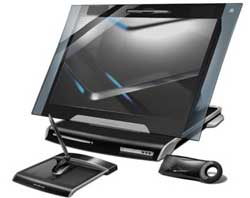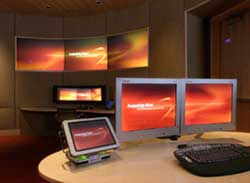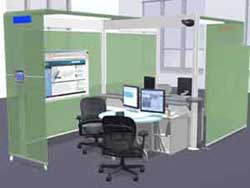The office space is preparing to witness a revolution called technology. An office of the future will break the boundaries of four walls to become a world without distance.
1. Anywhere is an Office
 |
|
Personal Internet Communication Device (PIC). -Photo: Gizmodo |
In reality, with the rise of new technologies such as PDAs and Wi-Fi, perhaps in the future, people won’t even need to go to work anymore. Imagine, each morning, there will be no more traffic jams and crowds rushing out onto the streets. Similarly, at dusk, there will be no more frantic scenes of people hurriedly leaving work for home.
Another technology likely paving the way for the arrival of the @Office is the Personal Internet Communication Device (PIC). This affordable user device is designed to provide controlled internet connectivity for the global consumer market. With PIC, you will be able to communicate, entertain, and learn anywhere in the world. Although it is not a computer, the PIC still runs on AMD processor architecture.
2. High-Tech Teamwork
 |
| Photo: Infoworld |
New technologies and tools for teamwork make it even less necessary for you to set foot in the office and sit at your desk every day. In the near future, you will be able to lounge in a park, diligently crafting a very important email. You could even present live to the corporate board via video conferencing while keeping an eye on your kids playing in… the park.
Does it sound too much like science fiction? Not at all, all these scenarios, and even more, are likely to become reality in just three to four years.
3. Microsoft’s Dream
 |
|
Photo: InfoTech |
The software giant Microsoft is working hard to develop new software and technologies that will make the dream of the future office a reality. A prototype of an ideal “Box” has been displayed right in the lobby of the company’s headquarters in Redmond. A series of cameras are deployed to capture 360-degree images of each remote meeting participant. The faces of each speaker are also displayed up close on the main screen. The common idea is to minimize misunderstandings that often occur in phone meetings or conferences, as sometimes voices are unclear or the parties on either end cannot distinguish if the other is being serious or joking.
Microsoft also plans to develop a computer screen with the same size as a real person. All participants in the meeting will be able to view and update the information displayed on the screen.
4. Farewell to Secretaries
 |
| Photo: InfoTech |
In the office of the future, you may even say goodbye to your personal assistants or secretaries. The Sandia National Laboratories is developing a program capable of automatically summarizing the most important points discussed during meetings… This is especially useful for those who are forgetful and cannot maintain high concentration during meetings.
5. Simplified Security
 |
|
Photo: InfoTech |
Researchers are also developing new technologies that will allow you to completely forget about long, complicated passwords. This is great news for those whose minds often drift. With this technology called “Click it”, instead of struggling to enter a 10-digit password or scan your retina to start your computer, users will simply click on 10 arbitrary points on an image requested by the system (Microsoft experts believe that images are always easier to remember than numbers).
Additionally, employees can wear RFID badges (radio-frequency identification), which automatically notify the computer when you enter the office. The computer will automatically start up and open the exact document you were working on the night before.
6. IBM BlueSpace
 |
| Photo: InfoTech |
Not to be outdone, IBM is also experimenting with several technologies promising to transform the office environment in the new decade. In collaboration with Steelcase, a well-known office furniture company, IBM has established BlueSpace – a space where interaction is pushed to the ultimate limits.
For example, a sensor screen nearby will inform you of the current locations of other members, automatically messaging them via instant messaging. In every meeting or discussion, documents or emails will be projected onto the meeting table. Everyone can read and annotate documents directly with their fingers – the motion sensors in the projector will automatically “translate” finger movements into underlines or circles at key points. The cost of setting up a BlueSpace-style office is around $5,000.
Of course, these dream technologies need to be much cheaper before they can be commercialized and brought to market. We will have to wait at least another three or four years before we can truly eat, drink, sleep, and breathe in the office environment of the new era – the high-tech era.
Thien Yi

















































